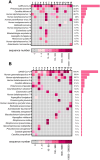Analysis of coinfections in patients with hematologic malignancies and COVID-19 by next-generation sequencing of bronchoalveolar lavage fluid
- PMID: 39623478
- PMCID: PMC11613933
- DOI: 10.1186/s40001-024-02180-0
Analysis of coinfections in patients with hematologic malignancies and COVID-19 by next-generation sequencing of bronchoalveolar lavage fluid
Abstract
Background: Coinfections in patients with coronavirus disease 2019 (COVID-19) affect patient prognosis. Patients with hematologic malignancies (HMs) are usually immunosuppressed and may be at high risk of coinfection, but few related data have been reported. Here, we conducted a retrospective study to explore coinfections in patients with HMs and COVID-19 by next-generation sequencing (NGS) of bronchoalveolar lavage fluid (BALF).
Methods: The data of hospitalized patients with pneumonia who underwent NGS analysis of BALF were reviewed. COVID-19 patients with HMs were enrolled in the HM group, and those without HMs were enrolled in the non-HM group. The coinfections of the two groups identified by NGS were analyzed.
Results: Fifteen patients were enrolled in the HM group, and 14 patients were enrolled in the non-HM group. The coinfection rates in the HM group and non-HM group were 80.0% and 85.7%, respectively. The percentage of coinfected bacteria in the HM group was significantly lower than that in the non-HM group (20.0% vs 71.4%, p = 0.005). The coinfection rates of fungi and viruses were 60.0% and 35.7%, respectively, in the HM group and 35.7% and 78.6%, respectively, in the non-HM group, with no significant differences. The most common coexisting pathogen in patients with HMs was Pneumocystis jirovecii (33.3%), and the most common coexisting pathogen in patients without HMs was human gammaherpesvirus 4 (50%). Coinfection with herpesviruses occurred frequently in both groups.
Conclusions: Our study showed that the majority of hospitalized patients with COVID-19 are likely to be co-infected with other pathogens. Pneumocystis jiroveci and herpesvirus are commonly coinfected pathogens in patients with HMs. Bacterial coinfection is rare in patients with HMs but is more common in patients without HMs.
Keywords: COVID-19; Coinfection; Hematologic malignancy; Next-generation sequencing.
© 2024. The Author(s).
Conflict of interest statement
Declarations. Ethics approval and consent to participate: The study was approved by the Ethical Review Committee of Ningbo Medical Center Lihuili Hospital (approval No. YJZ2023SL2). The procedures used in this study adhere to the tenets of the Declaration of Helsinki. Informed consent was obtained from all subjects and/or their legal guardian(s). Consent for publication: Not applicable. Competing interests: The authors declare no competing interests.
Figures





Similar articles
-
Fungi identified via next-generation sequencing in bronchoalveolar lavage fluid among patients with COVID-19: a retrospective study.Eur J Med Res. 2024 Sep 17;29(1):463. doi: 10.1186/s40001-024-02054-5. Eur J Med Res. 2024. PMID: 39289769 Free PMC article.
-
Coinfections with Other Respiratory Pathogens among Patients with COVID-19.Microbiol Spectr. 2021 Sep 3;9(1):e0016321. doi: 10.1128/Spectrum.00163-21. Epub 2021 Jul 21. Microbiol Spectr. 2021. PMID: 34287033 Free PMC article.
-
Diagnostic Value of Bronchoalveolar Lavage Fluid Metagenomic Next-Generation Sequencing in Pneumocystis jirovecii Pneumonia in Non-HIV Immunosuppressed Patients.Front Cell Infect Microbiol. 2022 Apr 8;12:872813. doi: 10.3389/fcimb.2022.872813. eCollection 2022. Front Cell Infect Microbiol. 2022. PMID: 35463643 Free PMC article.
-
Bacterial Coinfections in Coronavirus Disease 2019.Trends Microbiol. 2021 Oct;29(10):930-941. doi: 10.1016/j.tim.2021.03.018. Epub 2021 Apr 8. Trends Microbiol. 2021. PMID: 33934980 Free PMC article. Review.
-
Narrative review of the relationship between COVID-19 and PJP: does it represent coinfection or colonization?Infection. 2021 Dec;49(6):1079-1090. doi: 10.1007/s15010-021-01630-9. Epub 2021 May 31. Infection. 2021. PMID: 34059997 Free PMC article. Review.
Cited by
-
Post-pandemic recommendations for the management of COVID-19 in patients with haematological malignancies or undergoing cellular therapy, from the European Conference on Infections in Leukaemia (ECIL-10).Leukemia. 2025 Jun 2. doi: 10.1038/s41375-025-02649-9. Online ahead of print. Leukemia. 2025. PMID: 40456838 Review.
References
-
- Xie J, Wang Q, Xu Y, Zhang T, Chen L, Zuo X, et al. Clinical characteristics, laboratory abnormalities and CT findings of COVID-19 patients and risk factors of severe disease: a systematic review and meta-analysis. Ann Palliat Med. 2021;10(2):1928–49. - PubMed
MeSH terms
Grants and funding
LinkOut - more resources
Full Text Sources
Medical

